Boat Profile
A Stevenson project
From Issue March 2020
T he Weekender is a plywood gaff-sloop pocket yacht designed by Peter Stevenson and first presented to the public in a two-page article in the March 1981 issue of Popular Science magazine. In the decades that have followed, it has been a very popular design. I was drawn to its classic look and simple construction. Eager to learn how to sail—and to find out if my wife would enjoy sailing too—I was excited about the journey of the build and encouraged by the many helpful examples of other builders who are linked to the Stevenson website.
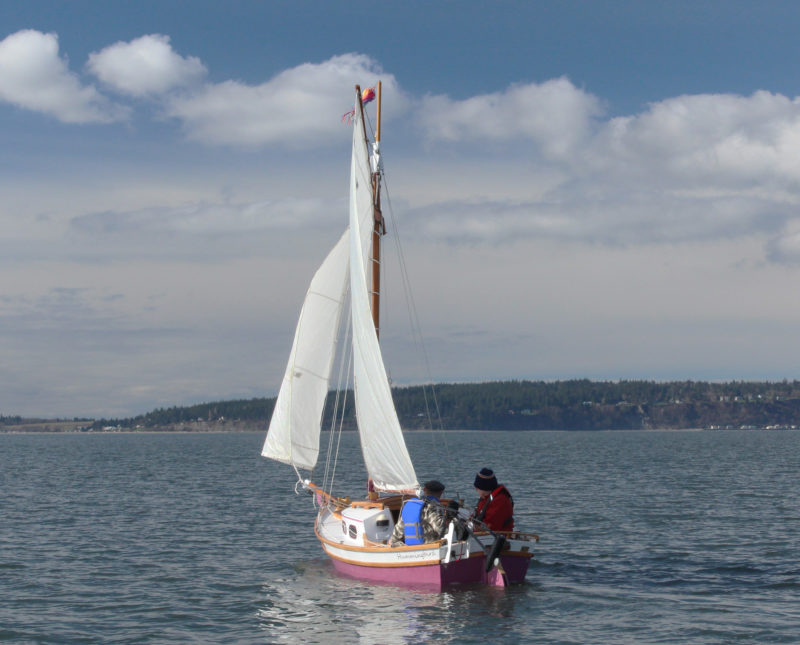
The Weekender draws 3′ with the rudder deployed; with its blade retracted, the hull draws 1′.
I bought the set of plans and the two companion DVDs. The combination of the 44 printed pages and three-and-a-half hours of video were helpful, entertaining, and, above all, encouraging. The plans are well illustrated with some photos and many nice drawings. There are no full-sized patterns, so each part is drawn right onto the materials. Step-by-step instructions keep the process going in the correct order. As a shipbuilder, I found the instructions clear and straightforward. My granddaughter, who was three years old when we started and nearly seven when we finished, was as eager to build the boat as I was, and we watched the video instructions several times together. Even at her young age, she could recognize the steps we had completed and the ones we had yet to accomplish, a good indication of how easy the plans were to follow. For me, the video clarified the few places in the plans that I was having difficulty understanding. Mike Stevenson, Peter’s son, who took over the business, has assured me that the most recent revision has eliminated some of those sticking points.
The Weekender has a very unusual construction: it is built right-side up with the stem and keel serving as the strongback. The deep keel and its integral stem are made of three laminates of 4/4 pine, fir, or mahogany. The keel, 10″ at its deepest, is rigid enough to support the build. I built a cradle to hold it upright throughout the build. Plywood is joined with butt plates to get the necessary length and width for the bottom panel; the bottom is attached to keel with screws and epoxy. The deck is added and secured at the stem and then temporarily propped up until the transom and three bulkheads are installed. The side panels go on next and they’ll extend above the deck to become part of a toerail. The construction then follows a more common sequence, with the assembly of the cockpit and the cabin. The hull, deck, cockpit, and cabin are sheathed with 6-oz fiberglass and epoxy.
The plans indicate a solid mast, and I built mine as per the instructions; however, a lighter hollow version would be much easier to raise. Details to build the wheel, trailboards, towing bitt, and bowsprit are included. There is also an option included to add a taffrail.
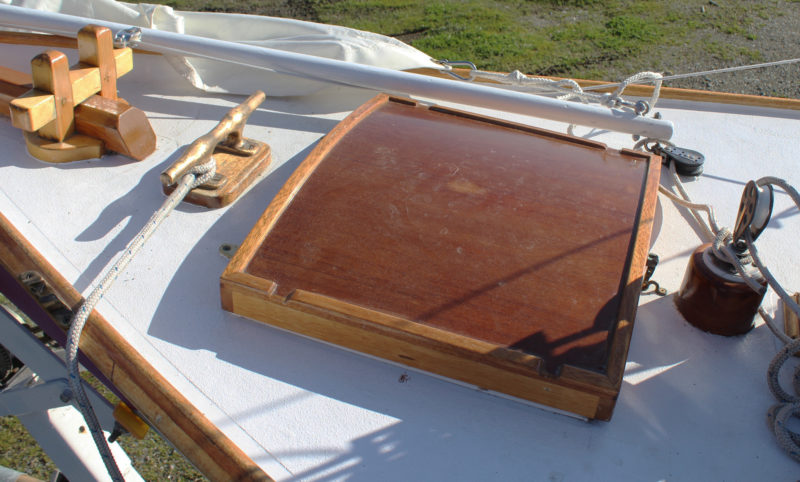
The forward hatch provides access to the storage space in the bow. The block to the right, held upright by a spring, is for the single sheet that controls the jib boom.
M y PT Cruiser has enough power to pull our Weekender. The boat has a somewhat deep keel for a flat-bottomed boat, so bunks are required under chines to support the hull. At the ramp, it’s easiest to float the boat off the trailer; at shallow ramps it can be a bit of a struggle sliding it off, in part because the two batteries I use for the trolling-motor auxiliary power add significantly to the Weekender’s weight. However, the boat can be winched up onto a trailer that’s not fully submerged. It takes as little as 30 minutes after arrival at the ramp to get the rigging in place and have it in the water; the most time-consuming part of launching and loading the boat is almost always the attention it attracts from people watching. When people gather around, the time at the ramp stretches out to a bit more than an hour.
The mast tabernacle is created with two strap hinges—one aft to act as the pivot, and one forward with a loose pin to lock the mast upright—and it works well. The two pairs of shrouds have turnbuckles that are adjusted each time the mast is raised; they remain connected, and only the forestay is removed for lowering the mast.
The 5’ bowsprit is fixed and anchors the forestay at its tip and the jib’s 60″ clubfoot at its middle. The club foot pivots about halfway out on the sprit, and the jib clears the mast when tacking and requires only a single sheet. I have added a downhaul to the jib so that I can both raise and lower the jib going no farther forward than the companionway. I also led the main’s throat and peak halyards to cockpit so I didn’t have to go forward to the mast to drop the sails.
To help keep the mainsail from overwhelming the cockpit when it’s lowered, I added lazyjacks. The plans specify eyebolts and a bit of pipe and metal strapping to make the gooseneck; I instead made an aluminum gooseneck with an extension that allows me to pivot the boom fully vertical and scandalize the mainsail. When coming into harbor, it’s a quick way to douse the mainsail and clear the cockpit for docking. This has proven most helpful especially when sailing alone. I also fabricated an aluminum masthead fitting to help with the rigging and give me a base for an anchor light and a wind-sock vane.
The rudder is in a rudder box that is an integral part of the tiller arm that is connected by lines and pulleys to facilitate a wheel. The rudder must be pivoted and locked up for transport. The wheel keeps the cockpit free of a long tiller that would most certainly use up the limited space. I find it quite handy.
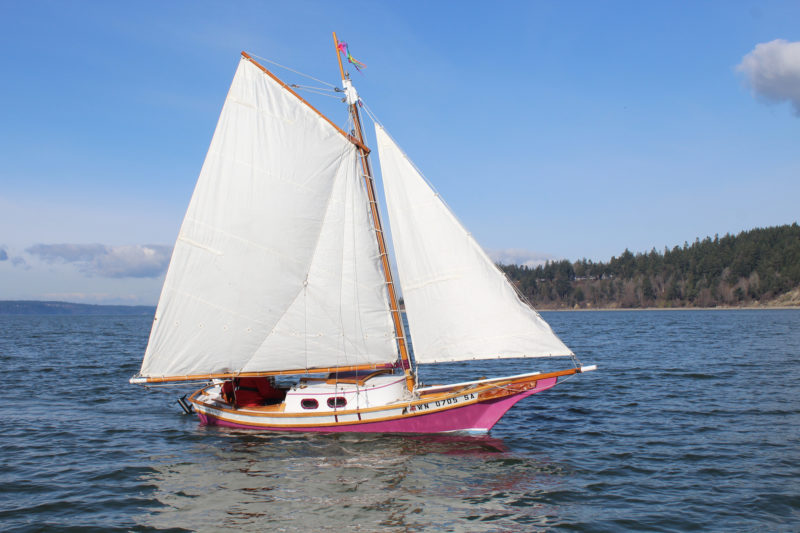
The Weekender carries a total of 120 sq ft of sail. The jib, with its boom and single sheet, is self tending, so tacking is uncomplicated.
U nder sail, the Weekender is like a sports car and very snappy in response on most points of sail. It can sail remarkably close to the wind for a gaff rig, and the self-tending jib makes tacking a snap. Its club foot is an excellent touch to the rigging, making singlehanding very simple. The Weekender can ghost along with hardly any discernible wind, although in light air it can be a bit hard to tack if the boat doesn’t have quite enough way on; the long keel requires some momentum to overcome its resistance to sweeping sideways when tacking. I have found that moving my weight to the downwind side forces the boat to heel, and it will gain speed and increase its ability to turn.
The Weekender is a pretty stable little boat, and ours is made a bit more so by the weight of the batteries for the trolling motor. It is stable when one is standing on the foredeck; however, it is a small boat, so if you step off-center it will move accordingly. But I have never felt that it was going to come out from under me.
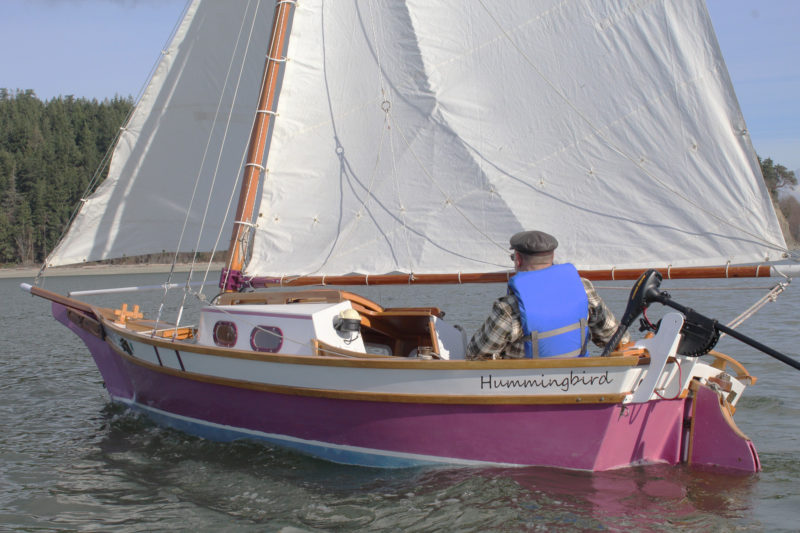
The Weekender was initially designed with a centerboard, but the full keel provided good performance to windward and the board and trunk were eliminated from the design, freeing up cabin space.
The hull can take waves better than one might guess for being so close to the water. The flat bottom can slap a bit depending on the angle of approach to the waves, but that same flat bottom can also surf down waves quite well, getting some help from the broach-countering directional stability of the full-length keel. I have found the cockpit to be generally dry with only occasional spray from hitting a larger wave. I prefer fair-weather sailing with our boat. When running dead downwind, wing-on-wing, the boat performs well; it’s a comfortable point of sail for the crew, with the hull sitting pretty much bolt upright.
For auxiliary power, we have a 55-lb-thrust electric trolling motor. While the plans call for a mount made of a 2″ x 10″ chunk of wood through-bolted to the transom, I designed and welded an aluminum bracket. The motor pushes the boat at just the right speed for harbor maneuvers, and provides an occasional boost to make a tack in light air. I have the two batteries on separate switches, but they can be combined for back-up power. I have run out of power only when I forgot to charge one of the batteries.
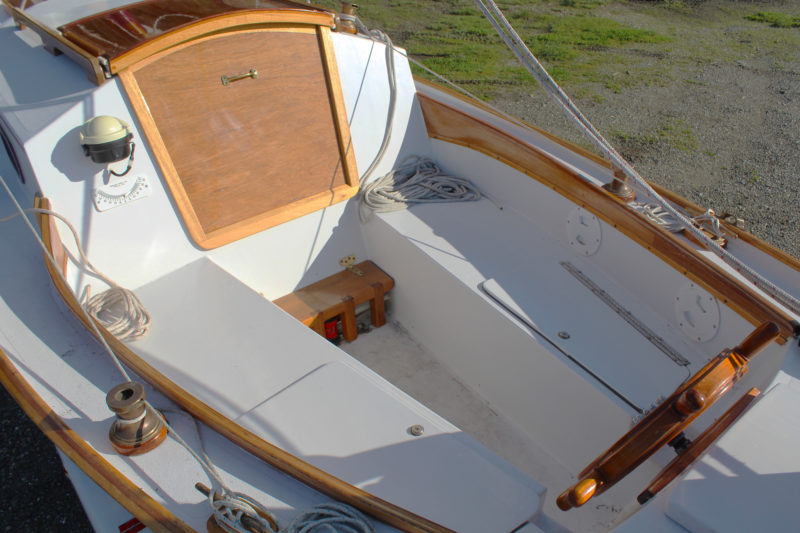
The cockpit benches include dry storage compartment aft and extensions of the cabin space forward.
The cockpit is not large, but it has enough room for the me and my wife to be comfortable, even when we’re sailing with our granddaughter and our small dog. The cockpit footwell is not self-draining and we have been caught several times in squalls that filled half of the cockpit, so I added a bilge pump under the hinged step at the forward end of the cockpit. The cockpit seats have hatches, and aft sections serve as storage. The curved coaming, shaped from a stack of 4/4 stock, makes a comfortable backrest and keeps water out when the toerail is in the water under sail. I cold-molded my coaming out of 1/8″ x 2″ sapele.
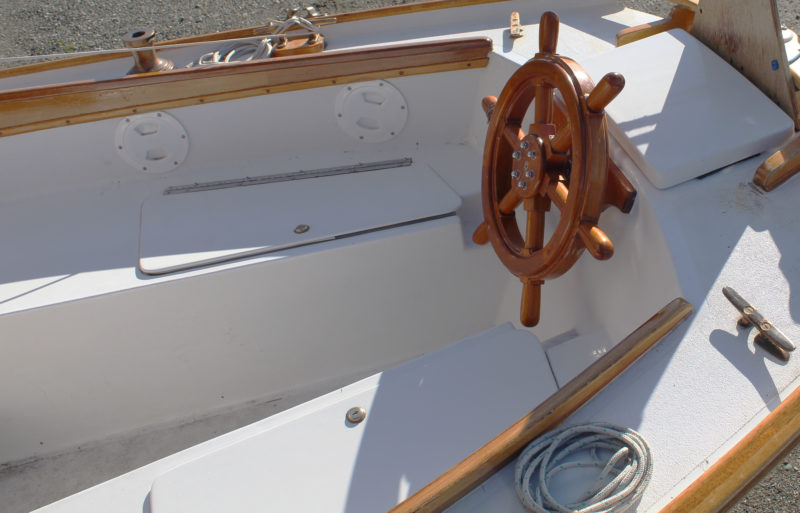
The wheel is more than an affectation. It doesn’t crowd the cockpit as a tiller would.
I added running lights to our Weekender as well as a small LED to illuminate the cockpit for the times when we are out later than expected or after dark at anchor. My wife and I have slept aboard comfortably on several occasions. We rig a boom tent for privacy and rain protection so we can keep the companionway open through a warm night; to clear the berths, we move most of the gear that usually resides in the cabin into the cockpit. The bottom serves as the berth and is flat, save for one transverse butt block, but with foam mattresses it’s not noticeable. The space works best sleeping with heads forward and our feet aft to take advantage of the space under the cockpit benches. Shelves with rails on their sides are a nice feature and are in fact part of the rigid framing.
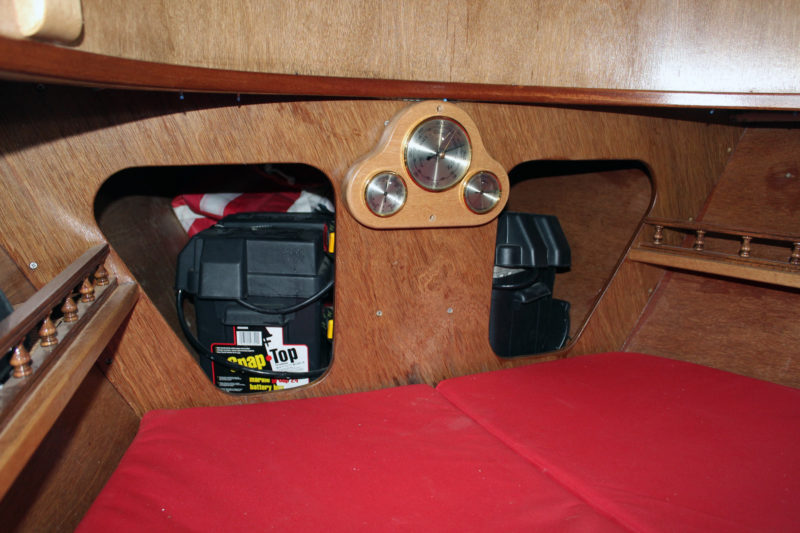
The bulkhead at the forward end of the cabin allows access to the storage compartment in the bow. Rails on the shelves port and starboard keep gear in place while under sail.
T he designed cabin has sitting headroom if you are of average height—I made our cabin a couple of inches higher than the design, for even more sitting headroom. There is no cabin footwell, so sitting is with legs outstretched on the bottom. There is access through the forward bulkhead to storage space under the foredeck, but it is easiest to use the foredeck hatch for larger items. The storage bin/seat at the companionway has proven to be a great addition for holding safety equipment, and it has also been a good speaker box for our CD player.
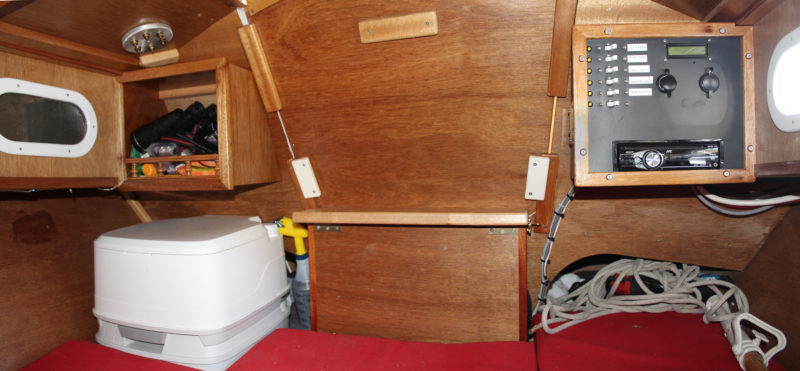
The aft end of the cabin provides a place to stow a portable toilet when it’s not in use. At right, one of the spaces under the cockpit benches is visible.
Ken Hauenstein lives in Burlington, Washington, just a few miles from Puget Sound, and is a general contractor who does all manner of work including interior boat remodels. He dreamed of working with boats from an early age and had his first real exposure working in a boat factory building interiors for cabin cruisers. He later worked in various shipyards and ran his own cabinet shop. His last shipyard job ended in 2017 as he made plans to retire. He started HUMMINGBIRD while working there. Since then he has built two dinghies, one wood and one aluminum. He is currently building a large aluminum ketch. He hasn’t set a launch date, and won’t because he finds the work therapeutic and likes to give the details all the attention they deserve.

Weekender Particulars
LOA/19′ 6″ LOD/16′ Beam/6′ Draft/3′ (1′’ with the rudder up) Hull weight/550 lbs Sail area/120 sq ft Crew capacity/Daysailing, up to four; Overnight, two cozily, one easily Auxiliary Power/up to 5 hp outboard or 45-lb thrust electric
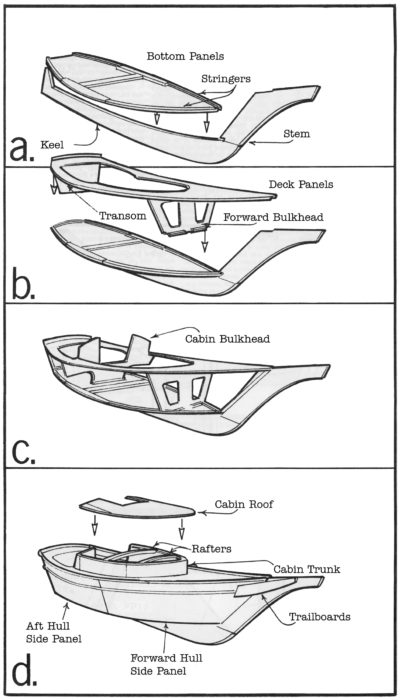
Plans ($45) and DVDs ($57) for the Weekender are available from Stevenson Projects .
Is there a boat you’d like to know more about? Have you built one that you think other Small Boats Magazine readers would enjoy? Please email us!
Share this article
Join The Conversation
We welcome your comments about this article. If you’d like to include a photo or a video with your comment, please email the file or link.
Comments (44)
Is there really enough headroom to use the porta-potti in the cabin?
The headroom in the cabin is limited to sitting, so the porta-potti is just stored there. I took the photographs for the review and I had only enough headroom for sitting on the floor cushions.
The cushions in the cabin have a removable section to move the porta-potti into the companionway should the need be dire. We have never used it since we put it in there however.
First, I would congratulate you for the amazing job you have done. I appreciate it as I’m currently building a Weekender for some time. The hull is quite finished now and the next step is the rig. I would be very interested in getting some pictures of the gooseneck and masthead that are looking very practical and better looking than the instructions suggested. J-Guy
I love my Weekender! It is indeed fun, stable and dry. Hoping this season to get a better video than this one from my iPhone.
J-Guy, Here are photos of the gooseneck and masthead fittings.
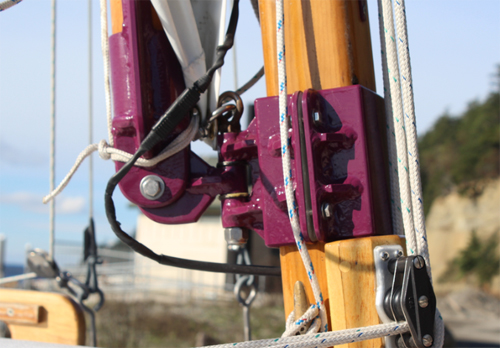
Who fabricated that for you?
Mark, I fabricated those myself. I was project manager in a shipyard while building HUMMINGBIRD and most of the parts I needed for them came out of the scrap bin. I fit and weld aluminum and steel.
When trailing: a) Does one unship the bowsprit so as not to need a trailer with a long front tongue? b) Do the spars stow within the length of the deck or overhang? Thanks in advance
I enjoyed the Weekender article, especially because I have built one of these boats. I hope this photo of my boat on the trailer will help answer Simon’s question. Notice I bolted on a short 2 x 10 forward on the trailer to carry the outboard motor, which is easily carried to the transom prior to launch. This way, potholes on the highway don’t bother me so much. The boat sets up quickly for sailing.The trailer is a bit large for the boat. The wider and lower bass-boat-size trailer gives a better towing experience and it all still fits in my garage.
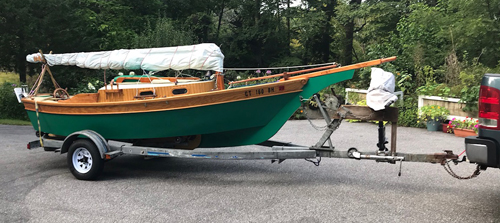
I have built and sailed a Weekender. I sailed it for four years. I have 30 years of sailing experience, and can tell you this design has some very serious flaws, mostly around safety, that I realized as I sailed it. First, it’s not self righting. At all. If you put it over, you are done. It will not pop back up, and becomes almost impossible to right again without help. And even if you get it back up, it cannot be bailed easily. And this assumes having as much flotation installed as you can! Without flotation, it might very well go under. It has no low ballast, which is a problem in many ways. Also, it has a very difficult time coming about. Very, very difficult time. It has to do with the sail plan, the hull shape, and the full length keel. I modified the keel quite a bit after the first year, adding to the center, and reducing it from the front 1/2, and that helped, but it still had a hard time coming about. This boat should only be sailed in very protected waters in 12 knots or less wind. it is easy to build, easy to trailer, and easy to beach, and looks very salty, but it has very poor sailing characteristics. Go to WoodenBoat’s forums and search for the Weekender. I wished I had before I built it!
I’ve made five Weekenders, two Vacationers, and two Skipjacks, and all have very similar hull forms. We have sailed them in a broad range of conditions and locations. They tack fine, they point better than they probably should, and they just work. I’ve never capsized any of them, although I have felt them being overpowered at times and adjusted accordingly by easing off, reefing, or heading back in. There are all sorts of responses to strong wind, depending on the boat and the days.
I’m sorry that John built one of our Weekenders without really understanding what the boat is and what it is not. Like many pocket cruisers, the Weekender is not a ballasted, self-righting boat. Self-righting isn’t a standard that many sailing dinghy, pod-type boats, open sailing skiffs, dories, or other traditional boats meet.
I just fielded a query from a customer a few days ago about whether to add ballast or not to a Skipjack, our 14’ open-cockpit gaff sloop. He had wanted to add 300 lbs of ballast to the keel of a 240-lb boat. The boat’s structure is not designed for this load, and the addition of ballast that close to the hull bottom and not extended away from it on a keel just wouldn’t be that helpful and wouldn’t make the boat self-righting. If someone doesn’t know how to sail an open dinghy, it’s probably not for them.
I’m sorry John had trouble sailing his Weekender, but we think the design sails well, given the limitations of a low-aspect-ratio gaff rig and a modified dory-type hull form. Over the decades, we have had a far more positive letters, emails, and phone calls about these boats than negative. Even the review here reflects this. We are sensitive to the fact that there are people who don’t have a feel for sailing these types of boats, or perhaps haven’t the range or depth of experience to draw from, and might well be frustrated that tacking a Weekender is not like tacking like a Capri 14 or some similar easy-to-sail machine with a centerboard. We have a section in the plans to help with sailing and tacking, and a good amount of discussion in the video as well.
I am truly sorry to hear, and entirely sympathetic with the unhappiness of having spent a lot of time building a boat only to be disappointed by it, but I don’t think that necessarily indicates a failing of the boat design. The Weekender, like the Vacationer and Skipjack, does tack fine, and it is an unballasted boat that is not self-righting. That’s the nature of the beast, and I’m sorry if it didn’t meet the expectations of a different boat.
I don’t think it’s possible to come up with a perfect design which will please and be all things to everyone. We surely don’t want to even hint that our little Weekender is anything like that. It is what it is: a cute, easy-to-build little sailboat with a classic-boat feel.
Mike Stevenson Stevenson Projects
I’ve had one I built for 19 years. I have had a lot of fun with my little boat, and it’s still happily sailing every summer. I sail her pretty enthusiastically, and have not had any problems. My dinghy-sailing training from when I was a kid prepared me for sailing a small, unballasted boat, so I didn’t suffer from any of the misapprehensions some folk seem to when they expect this boat to behave like a large, ballasted, round-bottomed keelboat- even when they ought to know better considering they built it themselves. It’s a fun little dinghy and is just right for camping with the built-in shelter. It can be rowed with oars or propelled by a trolling motor. It’s great for poking around islands and beaches and campsites.
Hi, Could Keith Shergold help me with the placement of the oar lock location and what would be the best oar length for my Weekender sailboat? Where do you think the best spot for the midship cleat would be? I am also building the trailer for my Weekender, so if you know where the axle placement location is best (noted distance from the back of the cabin bulkhead at seat level). Note there is no other builder nearby to help get the spec. from, so I would appreciate any input. I am stuck at the plywood build finish stage, and need to know where to put the backing in so I can get doing the real scary stuff: fiberglassing. I do not have heat in my garage so I have to wait for a dry sunny day with no or light wind, for the right conditions. So one more question: How much epoxy did you need to ‘glass? This is important to know because I live at the Lake, West Cove, Alberta, Canada, and need to go over an hour to the nearest possible supplier. I do not know at this time who is still open.
I bought the plans 20 years ago and have been sailing fiberglass boats since. I bought the revised plans last month and have the means to follow through this time. MEYG will be sailing in 2021 or 2022 out of Fairport Harbor on Lake Erie. “Life is too short to sail an ugly boat.” ~Anonymous. I don’t plan to take her out in a gale, but I think she will be a great boat for a single handed-sailor.
As I have mentioned before, I’ll put in a plug for water ballast. I like the clear poly water “cubes”, with a handle, as they come in different sizes (1 gal. to 5 gal.) and can be shifted easily as needed. One main advantage is that, in case of a capsize, the ballast has neutral buoyancy, and won’t sink the boat. Of course, water ballast won’t provide the righting moment that lead or iron sash weights will, but this safety factor to me is a strong argument.
At the end of the day, just dump the water out. No need to wrestle heavy ballast around once you’re back on shore.
Let me clarify: I’m not saying you shouldn’t build it. But if you are looking for a boat that seats more than three (and three is tight), is a responsive sailor, and you know you might get caught out in winds over 15 mph from time to time, this is not the boat for you. I decided to build this boat because of the way it looked, and its ease of building, and the fact that you use off-the-shelf parts for most of it. I realized afterword that I wanted a better performing boat. I sold it and bought a Montgomery 15, which is a better fit for me. And I will restate, I have a lot of sailing experience, and have sailed many different sizes and types of boats. This was the first I built. It does have problems coming about from time to time. Not always, but in certain wind conditions. At first I thought it was me, then after sailing other boats and coming back, I realized this design has some tacking problems. Is it a deal breaker? No. I would fall off a bit and try again, and could usually get through the second time. Pros: Easy to build esp. for beginners Easy to launch and trailer with pulpit design Can be beached Looks very salty Cons: Not self-righting or self-bailing Not a performance sailor Keep in protected waters Sail in winds under 12 knots (15 mph) unless you are an experienced sailor and have experienced crew
Here’s the Woodenboat Forum link . Lots of discussion here, and other folks with more experience than me. Same conclusions. Many defenders and detractors. I’m just stating my experience, and wish no ill will. It is easy to build, it looks great, and if you are looking for a boat to get out on a Saturday afternoon in protected waters, this is a great choice. It’s sailing characteristics are okay to good.
Thanks, John!
I appreciate your honest assessments and comments. It’s nice to have balanced forums and genuine information for people to learn from.
Mike Stevenson Projects
John, We have had one occasion in which an odd wind shear hit us during a tack and we rolled far enough to scoop water with the cockpit coamings. My wife got pretty wet. I let go the main sheet and she righted immediately. I have found the two batteries in the fore-peak do add a bit to her righting ability.
Hi Ken, I saw your sailboat pictures. Your side deck and cabin top had round wooden spools. Being new to sailboat building for myself and having none in the area, I was wondering are they fixed turning posts, ratcheting posts, or winches? And what are their designed uses? Your boat looks really nice in the pictures. Just viewing them is enough to make me want to finish my Weekender. Thanks
Gerald, They are actually bronze winches I salvaged from a boat we cut up in the shipyard I used to work at. The side-deck winches I use rarely except to tie things off. The cabin top winch I use to raise the main. It adds a bit more purchase.
Sorry to hear John had such an unpleasant experience with his Weekender.
I built one over the course of 7 years, making only one change to the plans … two 10″ x 18″ lexan panels on either side of the keel just forward of the storage box in the cabin giving me a “glass bottom” sailboat ! Helps the fishing and scalloping a great deal as our area ( Old Homosassa, Fl. 65 miles North of Tampa on the Gulf Coast ) has very ” skinny water”. That is anywhere from 24″ to 48″ unless one is in the river channels or the Gulf. HEART SONG has proven to be a very good sailor even in 20+ knot wind and seas in the Gulf. As always, the performance of a boat is generally equal to the performance of the crew.
As for self righting and being hard to tack ….. first of all … DO NOT cleat off or sit on the mainsheet ! If you get the lee rail in the water let the main out ! As for tacking … you will need to build up some good headway, then put the helm hard over in one quick motion (don’t be timid here). If in light airs it helps to backwind the jib, easily done with a club-foot jib.
What really helps here is to have some multi-hull sailing experience as the Weekender sails more like a “Multi” than a “Mono.” As for not being self-righting and difficult to tack, well the same can be said for one of the most popular afternoon sailboats ever built with over a million sailing worldwide. A design that has introduced thousand to the wonderful world of sailing. It’s called a HOBIE CAT. Our WEEKENDERS are in good company indeed !
Oh man, pictures please!
My wife and I had one of these in 1986 and sailed it on many lakes in Alaska. It was surprising how well it sailed. We were on Lake Louise one time and it was really blowing, we were getting pushed to the other side of the lake and we were getting concerned. I could not get the boat to come about, I finally insisted my wife raise the job and voila we came about and back to the dock. On another trip to Harding Lake we ended up racing a pretty modern ‘glass boat, I had the rail down in the water and water 1/2 way up the on the portholes, we ended up passing the other boat and we were hooked.
Great work! I just finished mine, have had a chance to sail it twice and am lovin’ it. I miss the build though – really enjoyed the process.
I was so excited to find a recent AND positive review on S.P. boats. My Pocket Cruiser is almost done and I am very happy with it. I made a few modifications, but overall it is great. Once I understood the type of boat it is and its positive attributes, it was perfect for my purposes. I am glad to see so many happy reviews. I’ve been planning to put an 86-lb trolling motor on it; I was so excited that a 55 -pounder does the trick.
Hello, Dennis,
I look forward to seeing your P.C. when you get it launched! I have a soft spot for that boat, as I did most of the design work on that one. It has a very different feel from the dory-type hulls: The beamier cat-boat-inspired hull is really mellow and relaxing! Peter and I were once sailing the prototype in shallow water and didn’t realize we’d caught one of the lee-boards in the mud! We were happily talking away, just enjoying the gentle slap of the water and the light breeze, and then one of us said “Hey! I don’t think we’re moving anymore!” We laughed and pulled the board up and jibed around out of the shoal, but it really was a funny, mellow moment! I hope you have great fun with yours! Mike Stevenson Projects
Are those the battery boxes I see in the forepeak? I suppose it would make sense to try to balance out the weight of two adults in the cockpit.
I know in our Weekenders, we put the batteries up forward. The boat likes a bit of weight up forward to balance things, as you noted. I hate the longer wire runs, but larger gauge wires and 24v motors help minimize the losses. Mike Stevenson Projects
Yes, those are the battery boxes. My thinking, in addition to what has already been mentioned, was that the extra weight at the base of the mast would help work against the leverage in those moments when you may have held the main sheet a little too long and to tight. As I mentioned earlier, it has proven to pull her back in tight circumstances.
I recognize a lot of the names posting, and give you my support. I am building a Vacationer, a few hours a day, and am within a few weeks of painting the hull. The amount of time it takes to build depends on the level of finish on the boat. I am looking forward to being able to sail mine.
I’ve been sailing my Weekender for ten years now and have made many modifications to it. I wouldn’t change the basic boat at all now that I have a fairly good idea about how to sail it. I thought about ballast, but no way. I have done a capsize test with my Weekender and can tell you that mine pops right up with a little push on the keel. I’ve got a ton of floatation in mine and she floated pretty high when I took her over. I have also found that she will sail pretty well on her side if I don’t get nervous.
I crossed the Straits of Mackinac in twenty knots of breeze with no drama at all. I typically sail in winds in the high teens gusting well over 20 with the only downside being my old hands get tired. After ten years of learning to sail, she has never gone over on me and unless I have a stroke at the tiller I doubt that she ever will.
All around, best boat I can imagine.
Al, I can’t tell you how much my father would have loved to read your note. He was always very personally affected by letters and emails and photos our builders sent in, which makes sense: A big part of why he designed things was to create fun for people. The original books he wrote about wooden toys came about because he just wanted to make some toys for me. That started a legacy of projects which just keeps going, and I’m very proud and thankful to be a part of it and to keep it rolling along!
I love your adventurous sailing nature! Thank you so much for sharing your fun and spirit with us all!
Mike, DUCKIE is my first boat build and even after building a number of wooden boats, she is still my ideal. What I mean about best all around boat is that she is by far the easiest boat to live with for this old man. I can manhandle her on her trailer, pull her with a Toyota Corolla, and handle all the wind I care to go out in. Set up and take down are the easiest that I have experienced, except for all the attention she gets at the ramp. Well, she did win her class at the Port Aransas show, so there’s that. She takes off like a scalded cat after a tack, which really turns my crank. She is way faster than most think she should be. On occasion, I have seriously perturbed skippers on bigger, supposedly faster boats by passing them and then waiting for them, good times. Describing her as a dirt bike on water is pretty apt. Her light-air ability is the best in my fleet. I could go on all day. Bottom line, learn how to sail a gaffer and take advantage of a sharp chine, and most will understand what I’m saying.
Al, I hear ya!! (and not just creator-bias: I have felt that kick in the pants when one tacks and Off We GO!)
All the best, and stay safe up thataway!
Very much enjoyed the article and all the discussions. She is a handsome little boat that I am sure is quite pleasurable to sail. I have a gaff-rigged Eastport pinky ketch and a Sedgwick Sailing peapod that I designed, based on the Washington County peapod shown in Chapelle’s book. She is 13’ 6”, reduced from 15’ 3” with a long straight keel. She tracks like she is on rails and accelerated rapidly. In response to the various comments regarding tacking, I have found that technique is key. Head up very slowly and just before you come up into the wind, kick the tiller over and voila! Never fails. There is no doubt you can have as much fun with a small boat as a big one. I’ve had a blast sailing with the Small Reach Regatta in Maine for the past few years. The Weekender would be a welcome participant. I always look forward to the monthly submissions. Thanks for sharing.
Yep, that sounds like great fun! I’d love to join you one of these years, if the Fates allow. I very much agree with you (not surprisingly!): The lightweight gaffer is a Fun Machine, and one only has to look at the shots of the sandbaggers of decades past to see the seriously-exciting-looking fun they seem to have been having!
All the best from the West Coast — Stay safe, all!
Great project! I fell in love with it as soon as I saw it. We should thank Peter for his talent for combining simplicity, reasonable seaworthiness, and beauty. I’ve already finished building my boat and I’m looking forward to going on a serious voyage.
I built my Weekender back in 2000 and completed her around 2005. Loved the building process and sailing her. I was truly amazed at just how well she handles and tracts. The gaff sail rig truly maximizes the sail area. Looking forward to building another one some day. And Mike, when I do I’ll order another set of plans from you. Great boat!
Beautiful workmanship! I especially love the character of the shipyard-leftovers and self-fabricated parts! How well suited would you say the sailing is to the area? Any modifications you’d make if you got to start all over again (besides the very sensible lights, headroom, etc. that you mentioned in the article)? I’m looking to build my first boat soon and I think I’m on the same water as you, Ken. Would definitely look forward to building a Weekender!
As a avid carpenter I am surprised at the absence of glassing after so much work into such a beautiful craft – I am envisioning a whole lot of screw joints coming ” disjointed ” as they eventually become wet and damp – What would be the offset to elevating the cabin roof another foot? Even at 2021-22 prices would anyone want a stiffer (rot-resistant) stem when putting this sprite under the stress of beaching, trailering, or keeling in a 25-knot wind? And ad yuears to her life? Well worth the mahogany or joined oak that she deserves. Comments welcome, especially those that have plied this beaut 10 years or better.
I have sailed my Weekender for over ten years now and can vouch for the toughness of the boat in all regards. I once sailed her up the rough concrete landing at a marina under full sail in twenty knots with no damage at all. I had a plastic shoe on the keel, but it was only scratched a bit. There was an avid crowd of witnesses at the time, and they were shocked to see me laughing and shoving her back in the water. If the landing is crowded, I always beach the boat out of the way to wait my turn, and over the years, my boat is like new. My keel is made of ACX 3/4 inch plywood which has stayed straight and un-degraded.
I glassed the entire outside, but left the interior for paint. I painted the interior very carefully to ensure that it would stand up to a dunking. As long as water doesn’t stand around inside she is okay.
I also added two inches to the height of the cabin, and I don’t think I would add more because I don’t want to ruin the look of the boat. I have noticed that the designers once built a Weekender with a pop up, or removable top. Not the worst idea if sitting upright is important. If I am going to spend any time in the cabin, I simply pile all my junk against the forward bulkhead and recline against that. I have also learned the drawbacks of too much windage, which the cabin is the primary culprit therein. You will notice it.
I`ve read this article about the Weekender Sailboat now twice. This is a very good description about the Weekender and I can really agree in all Points. I built one and yes it’s a joy to sail. I also raise the cabin height double than the original. It’s much comfortable. There is one Thing where I’m not so happy. The foredeck is drawn flat and the water can not flow overboard. Unfortunately I recognized it too late. In that time I was not so experienced in boatbuilding. Another thing was hard to learn the imperial measurements.
I present my Building Story on the Stevenson website. I hope you can enjoy
So thank you for this nice article to read.
With Kind regards from Germany!
Michael Beckmann
Leave a Reply Cancel reply
Your email address will not be published. Required fields are marked *
Stay On Course
More From This Issue
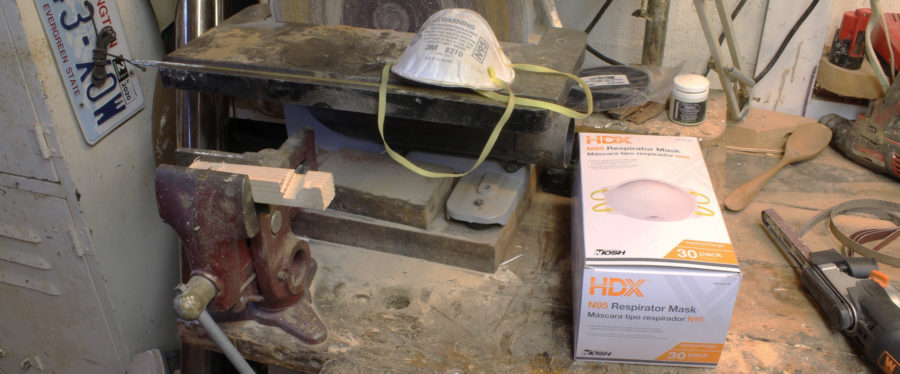
From The Editor
On January 23, I bought a box of 30 N-95 disposable dust masks at Home Depot for $21.47. They’ve been standard fare in my shop for decades, but a little…
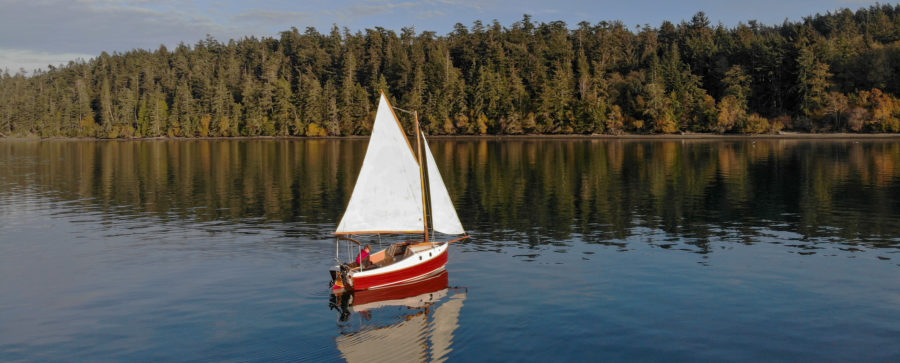
John Harris, the proprietor of and chief designer for Chesapeake Light Craft, designed the PocketShip as his personal boat. “I'd owned a production fiberglass pocket cruiser, which sailed well but…

Under sail, the Weekender is like a sports car and very snappy in response on most points of sail. It can sail remarkably close to the wind for a gaff…
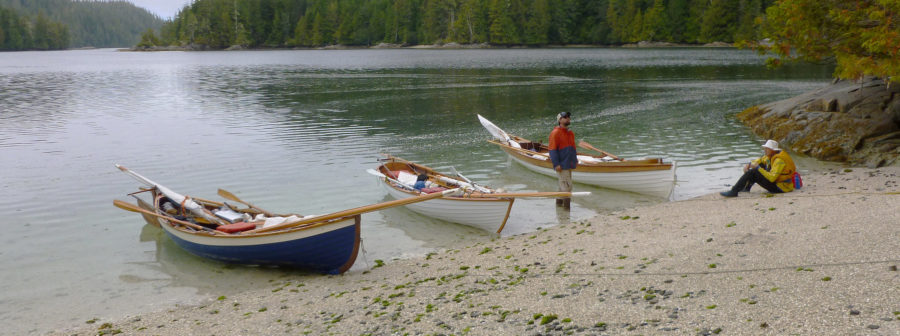
The Broughton Archipelago
We began with a 2-nautical-mile crossing to the wooded, low-lying Pearse Islands, and headed east by southeast. Immense whirlpools and gyres boiled up near Weynten Passage at the north end…

A DIY Cagoule
I lost track of my original cagoule, so I recently re-created a pattern and sewed up two new cagoules. The first was a bit tight over my knees when I…
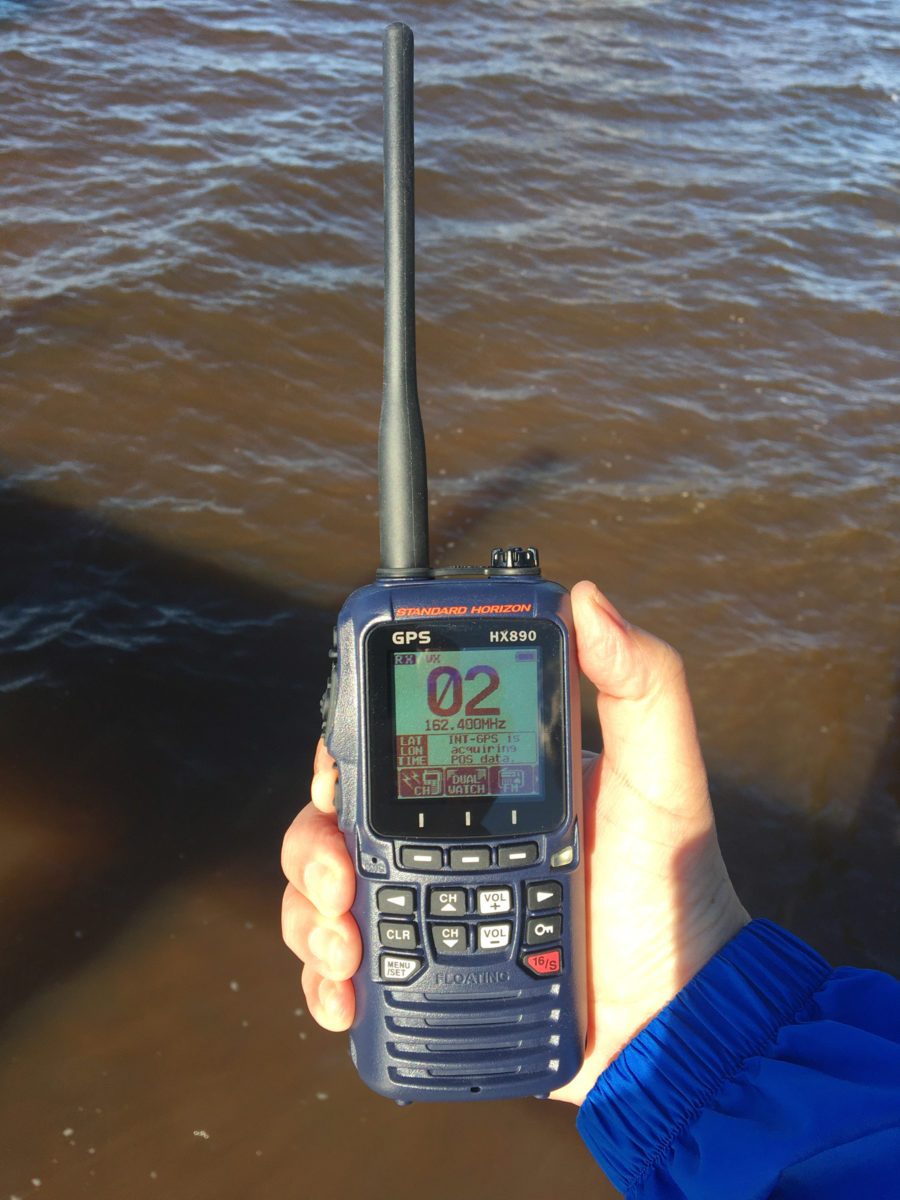
Product Reviews
A Full-Featured VHF/GPS
The HX890 floats and is submersible down to 1-1/2 meters for 30 minutes, important features for boating kit. It functions as a standard VHF marine-band two-way radio and can transmit…
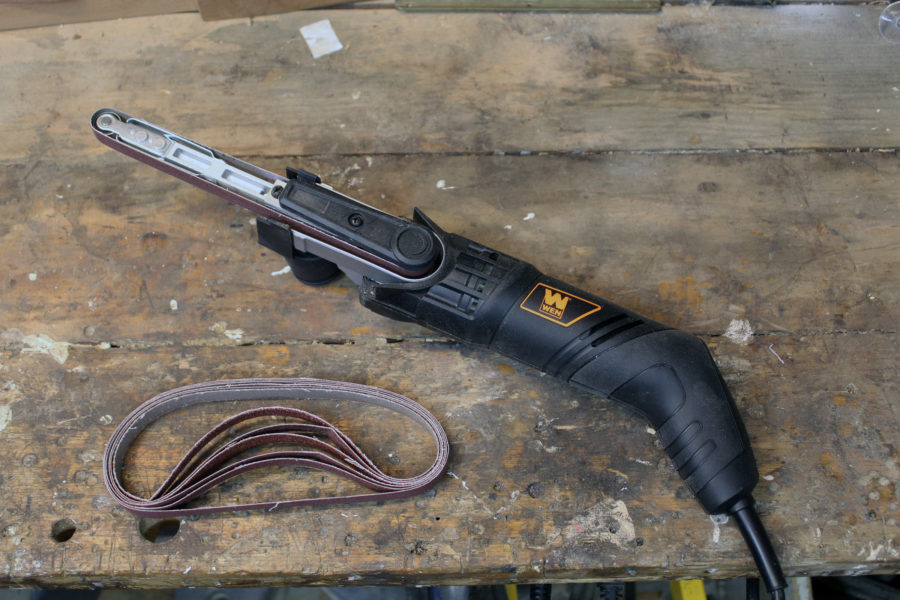
Wen Band File
Just behind the front roller there are two base plates, one on top, one on the bottom, that make contact with the sanding belt and back it up for working…
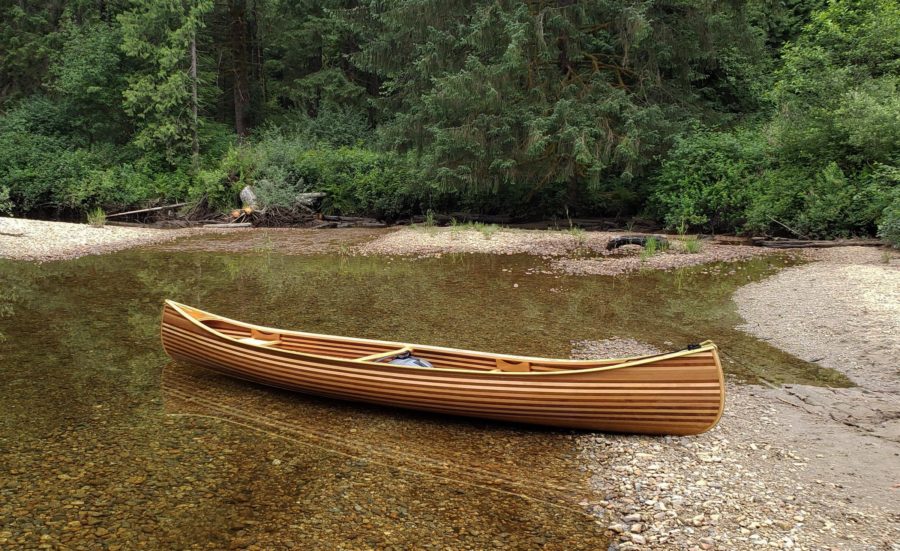
Reader Built Boats
The Yeung Canoe
That fall, Rebecca and Kimberly, now 14 and 12, began work on a Prospector Ranger 15 canoe kit from Bear Mountain Boats. Their father, Winston, helped with the project and…
More Boat Profile
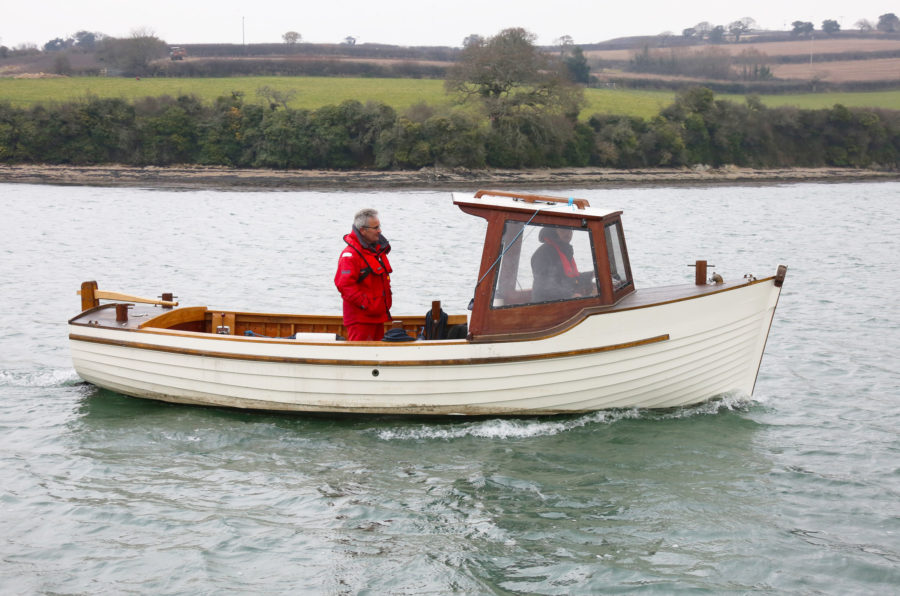
Beer Beach Boat
Alasdair Grant, had built STEADFAST, a 16′5″ version of a 15′3″ Beer Beach boat called WILD DUCK. Beer is a village located in the middle of the Lyme Bay coast,…
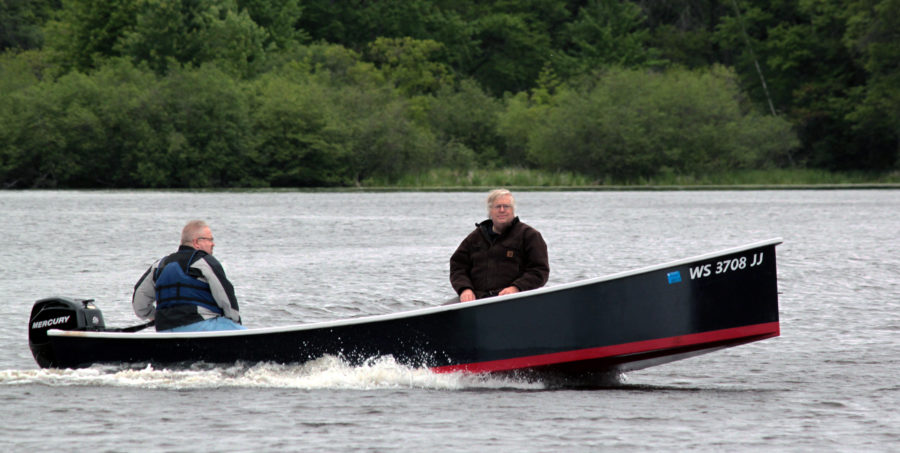
I’ve had a copy of Phil Bolger’s book Boats With An Open Mind for a long time, and I’ve always liked the looks of the Clam Skiff he designed for…

Like many of Welsford’s small-boat designs, the Sei combines a relatively narrow and flat bottom panel with three strakes of glued lapstrake planks over 1/4″-plywood frames. The hull is built…
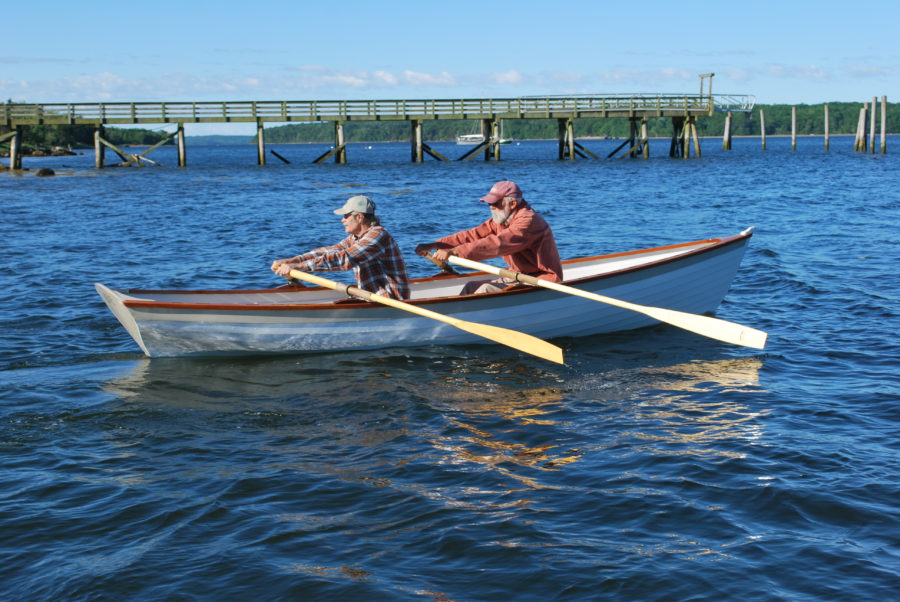
The Penobscot Wherry
The Penobscot Wherry from Cottrell Boatbuilding of Searsport, Maine, is based on the Lincolnville salmon wherry, a beamy high-volume boat used to remove salmon from weirs in the days when…
Subscribe Today!
Become a subscriber today and you’ll recieve a new issue every month plus unlimited access to our full archive of backlogged issues.
Already a subscriber? Sign In
Subscribe For Full Access
Flipbooks are available to paid subscribers only. Subscribe now or log in for access.

Stevenson Weekender
The following notes and photos were submitted by mark as part of his nomination for the 2016 Hal Harper award…
The following notes and photos were submitted by mark as part of his nomination for the 2016 Hal Harper award conducted annually by the NSW Wooden Boat Association. The Stevenson Weekender is a boat that borrows some good ideas from the golden age of working sail, as well as some new wrinkles from space-age materials. It's a project that combines the best of both worlds - the classic lines of the sea-wise sloops of the turn of the century - and the quick-to-build, lightweight, low maintenance of modern materials. What would one of the old master boat designers do with modern tools and materials? That was the question that the first Weekender set out to answer when the boat plans were featured in Popular Science magazine over 30 years ago in 1981. To date over 100,000 plans have been sold with the majority being built. A real testament to the cleverness of construction. Marks Weekender Hull Completed The result is an extremely rigid, self-aligning structure that pulls itself straight as it is built. This worked great for reducing building time, but it also had some other bonuses. Working with my son and friend the total build time from the purchase of plans to the first sail was 13 months. Inside, there's over six feet of sleeping room for two. The reason for the extra room inside is the absence of a centre board trunk that usually sits square in the middle of where you want to be. The extra room is what really makes the Weekender a pocket yacht, as two people can take it on a camping trip and still have a light, compact boat that's easy to trailer. To get a sense of the relative sizes of the Weekender I built a paper model first. Marks Weekender Interior Completed Hull-building was just like building a plywood box. After assembling the keel, we cut out the deck, bottom, and bulkhead parts, assembled the deck and hull bottom, screwed the bottom down onto the keel, then fitted the bulkheads and deck down in place. If we kept the centre lines of the parts lined up, there's no way the boat could come out lop-sided. And once the side panels are screwed to the edges of the deck and bottom, the whole box-section becomes extremely rigid. Inside, parts like seat-bottoms and shelves doubled as side-framing. You'll find a lot of parts on the Weekender doing double-duty. That's what keeps it light. (see construction order below) The shallow full-length keel and the hard chine of the hull bottom bit into the water and keep the boat sailing well into the wind. The Weekender's shape has a lot in common with one of the most seaworthy boats on the water, the Grand Banks Dory (with an added keelson and bowsprit). So she can handle some pretty nasty waves without making a big deal about it, and she's a nice, dry boat in the cockpit as well. Although the whole boat can be built from standard lumberyard stock and hardware, using common hand tools, mine was built with marine grade plywood, mahogany and Bote-Cote epoxy and fibreglass. The set up of the Weekender takes just a few minutes, and all we have to do to pack the boat away for trailering after a sail is to unhook the forestay, lay the mast back down over the lowered mainsail, and stuff the jib down into the forward hatch. Not a sail or line has to be removed. Set up, ready to sail The salty old gaff-head sail rig also turned out to have a lot of advantages. With the mainsail held on three sides by spars, it's easy to control the shape of the sail while underway. A Weekender under sail Stephenson’s Weekender Sailboat Specifications L.O.A.: 19'6" L.O.D.: 16' BEAM: 6' DRAFT: 3' (1' w/RUDDER UP) HULL WEIGHT: 550LBS SAIL AREA: 120 SQ.FT. SLEEPS TWO COSILY, ONE EASILY CREW; TWO AUXILARY POWER BY A 5HP OUTBOARD Who is Pete Stevenson and how did he go about designing the Weekender So how did an American surfer dude like Pete Stevenson become a boat designer in the first place? “Surfing's a good way to build an instinct for how solid shapes will be affected by water movement,” he said. “You're right there in the water, up close and personal, experiencing every way the fluid bounces off the shape and pushes it.” But his first attempt at boat design was a total disaster. He built an outrigger from one sheet of plywood and a chopped down telephone pole. Fortunately, he wasn’t on board when the whole thing disintegrated. “A couple of thugs paddled over and demanded to take the first test ride. We had no choice but swim in and watch what was supposed to be our fun. But then a thin white line of soup on the horizon announced what we used to call a "clean-up wave.” We watched with ill concealed glee as the big guys took gas in the rinse cycle. The remaining parts were so heavy we left them for bonfire fodder. We learned about ‘building light’ from that.” The next attempt was more successful, although it was simply the result of playful experimentation. “A number of guys would gather to down beers and argue about boat design. During one of these sessions I amused myself by seeing if I could cut out cardboard and tape together a little flat-sheet version of a Greek fishing Caique. I'd cut out the keel with stern and stem posts attached. Then I cut the double ended bottom, taped it to the keel, and cut and taped the sides together. The model looked pretty reasonable, although floppy in its taped together state. “Then when I pushed the decking with its centre cockpit down in between the sides, the thing suddenly went rigid. We threw it around like a football it was so strong.” Pete realized that with the right design, a strong boat could be built from very light materials without sacrificing rigidity. The result, after some more experimentation, was his first sailboat. Commercial success soon followed. “We built a 16-foot version and Monk Farnham, the venerable editor of Boating Magazine got wind of it and wanted to run it as DIY article. I told him I didn't know the first thing about drawing plans, so he said, ‘Well then I'll just send your dimensions over to Sparkman and Stephens and they can whip up some plans.’” “When I got a copy of the plans I was stumped. I wouldn't be able to build my own boat from these plans because they were set up for experienced shipwrights who knew which part to start with. From there on we started devising our own step-by-step plans, with information available on a ‘need to know’ basis. No fair looking ahead, you'll just get confused. Once you've done step four, step five will make sense to you.” What emerged, almost by accident, was a good looking boat that was easy to build and accompanied by user-friendly instructions. It was a winning combination—and arrived at just the right time. There was a strong interest in do-it-yourself projects at the time and national magazines were clamouring for novice-friendly woodworking projects. But most boat designers were not creating boats appropriate for inexperienced builders. “The craftsmen were all anxious to show off their expert fine finish, their exotic joinery, and their floor-standing tools on the parquet shop floor,” Pete said. Pete lacked these pretensions. He couldn’t look intimidating even if he tried. “When the representative of the plywood association got wind of us and stopped by for a look-see, I was pretty embarrassed at his first questions.” “‘So, where's your shop?’ he asked.” “ ‘Well, I do the cutting mostly out on the back porch. Sometimes I assemble things in the living room.’" “He just grunted.” “‘Let's take a look at your tools.’ I had a circular saw, a power jigsaw, a 3/8" (variable speed!) drill, and a Yankee screwdriver.” “What I didn't realize then was that this was just what he was looking for. Somebody with no shop, no particular fine-finish skills, and some ideas.” Pete’s big break came when his plans were published in—of all places—Family Circle magazine. The editor was a “boat nut,” Pete said, and approached him with an intriguing question: “‘You think you could get up a simple, cheap sailboat people could actually build?’ We did. At night, during the four a.m. sit-ups that freelancers stay in shape with, I'd wonder, ‘What moron would waste time creating a sailboat for a women's magazine?’” But this article produced a flood of orders. About 22,000 sets of plans were sold. Delighted with this success, the editor asked for more. “‘What other boats you got?’ the editor demanded. The next one sold 29,000 sets. Other magazines got on the bandwagon and pretty soon we were doing a series of pocket yachts for Popular Science. The first was the Weekender” The Weekender remains highly popular and can be found sailing around the world. But over the past quarter century, a great many new designers have entered the market, many focusing on the needs of inexperienced builders. For novice builders there’s an embarrassment of riches. So what accounts for the enduring success of this boat? Many people simply like how his boats look. They’re often called pretty or, more frequently “cute.” Pete accepts these comments with alacrity. “I'm a believer in looks when it comes to boats. They say, "If you can walk away from your boat without looking back, you've got the wrong boat.” But there’s more to it than that. What makes a Stevenson boat an enduring favourite, I believe, is that Pete has tapped into the fantasy of sailing. His designs capture the spirit of classic boats and the golden age of sail, something Pete freely acknowledges. “If our boats have a traditional kind of look and appeal, it's because … these pocket yachts of ours are based on forms that were worked out by real sailors at the pinnacle of working sail. The hull of the Weekender below deck is nothing but a Chesapeake Skipjack, The topsides are taken from a Friendship Sloop for its beauty and versatile function.” Pete’s real genius, however, was finding a way to transform these vintage lines into easy to assemble plywood panels. Like an artist making a quick sketch of a landscape, his designs embody the visual essence of a skipjack or sloop—without requiring builders to actually build something as complex as a “real” skipjack or sloop. Even first-time builders with a few simple tools get to enjoy the feel and fantasy of a traditional craft simply by building a plywood box. Not surprisingly, this nautical slight of hand makes Stevenson’s designs vulnerable to criticism by those who prefer to build traditional boats in traditional ways. Forums populated by builders more skilled than I have discussed whether or not the Weekender is, in fact, a “real” boat. Critics argue that Stevenson boats are heavy on romance but don’t offer much in terms of performance. Pete admits that performance is sometimes compromised. “Trade-offs, I think they're called,” he said. But all boats are a product of compromise and it’s not fair to criticize any boat for being one thing and not another. The real question is, What need is the designer satisfying? For Pete Stevenson, it’s clear that his primary goal was to design a good looking boat that just about anyone could build. On this score, he has succeeded. Even critics concede that lots of people buy Stevenson’s plans, that a large number of boats are eventually completed, and that most builders are proud and pleased with their results. Cabin of a typical Weekender Pete heard from a Sea Scout troop from Canada that took two Weekenders down the St. Lawrence. “And we heard from an Australian couple who spent two summers vacationing on their Weekender without getting a divorce.” In the end, I think that kind of “I don’t have to prove anything to anybody” sense of adventure captures why I was first attracted to the Weekender and, by extension, its designer. I can’t speak for all his builders, but I believe that Stevenson has tapped into the zeitgeist of guys like me who believe that boat building is about a great deal more than sailing. Pete’s boats capture that youthful yearning, give it a romantic shape, and make it accessible to anyone with a small garage and a circular saw.
Project Gallery

March / April Issue No. 297 Preview Now

Sailboats - Daysailers
The Stevenson Projects Weekender design is forty years old this year! Inspired by the classic lines of Friendship sloops, but translated to plywood, the Weekender has the looks of a classic era and the light-strong straight-forward simplicity of more modern materials. The Weekender is a fairly simple boat to build, as many of our first-time builders can attest to.Over the decades, hundreds of builders have come to love the boat as much as we do. It’s certainly a perennial favorite, both for us and our customers. 16′ on deck, just over 19′ overall, weighing in around 650-700lbs, with 120 sq. ft of sail.
Design Specifications
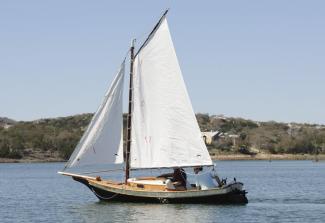
ACCESS TO EXPERIENCE
Subscribe today.
Publishing dynamic editorial content on boat design construction, and repair for more than 40 years.
1 YEAR SUBSCRIPTION (6 ISSUES)
Print $39.95, digital $28.00, print+digital $42.95, from plans & kits.
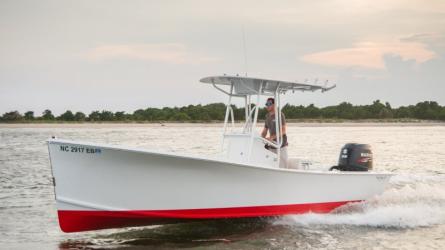
Core Sound 21
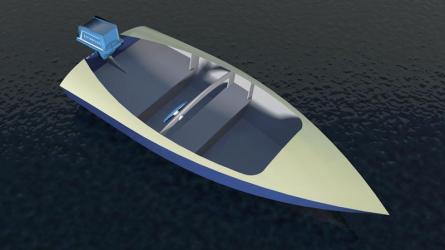
ROBERTS SPRAY 27
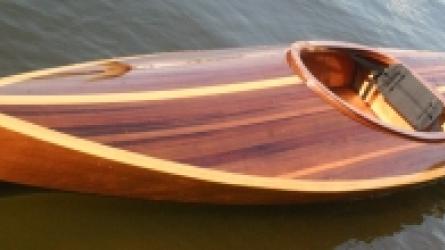
Wood Duck 10 Hybrid
From the community.
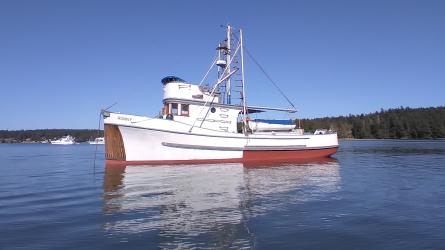
Classic 44' Tacoma Boatworks Trawler 1948
“Ronny” was built at the Tacoma Boat Works in Seattle in 1948.
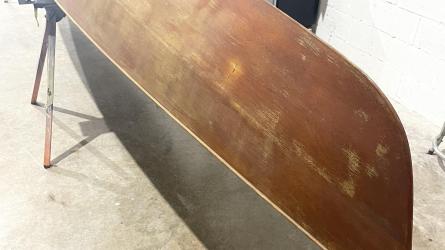

1986 Van Dam Pulling Boats
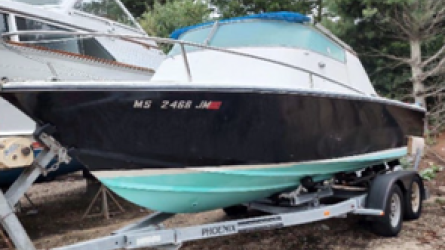
Vintage 1970 Highliner Gypsy
Many upgrades. $12,500. NO EMAIL. PHONE CALLS ONLY.
Register of Wooden Boats
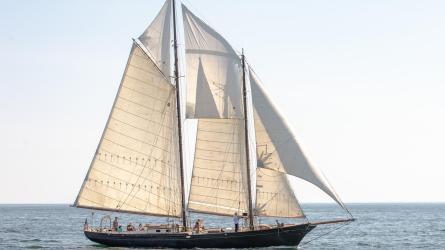
Tyrone is Sam Crocker’s design #202 launched 1939 at the Simms Brothers boatyard in Dorchester, M

- Remember me Not recommended on shared computers
Forgot your password?
Or sign in with one of these services
Stevenson Weekender

By corkman1958 June 21, 2011 in Main Forum
- Reply to this topic
- Start new topic
Recommended Posts
Corkman1958.
New to site and to pocket sailing. Just purchased an already built 19' weekender with Zieman trailer. I have a long history with boating, although very limited skills with sailing. In the process of stripping down the original paint on the hull. Any pointers would be appreciated.
The Sparrow

Link to comment
Share on other sites.

Looks like a lot of cleaning, painting and varnishing is in you near future. Welcome aboard . . .
Thanks. I'm sticking with the hull paint removal to start. Starting to extend the lower rub rail. Original owner/builder did not install this section. Can someone suggest a method to attach main sail to mast other than lashing. This has a gaff rig set up with tapered mast. I would like to use mast hoops. Have heard to cut 1/2" sections from 4" PVC couplings. Any other ideas?

Frank Hagan
A lot of us have used 1/2" wide sections of 4" DWV couplings (black ABS). They work fine; better if you ease the edges with sandpaper so they slip up and down the mast easier. See our Gaff Rig Main Sail article ... you have to scroll down about half way for the various methods used to attach the mains'l to a pole mast like the Weekender has.
Thanks. I will go with the ABS couplings to start with. What small thin lashing would be recommended to attach the sail grommets to the mast hoop. Until I feel comfortable with the un-powered craft, I want the sail to lower when I need it to (chicken-out)I don't need additional issues if in a crisis
You'll get better preformance with a sail track and slides, plus the sail will flake better too. Tracks are also much less prone to jam or bind as lasing or hoops can. Given the choice of hoops of lased, I'd take lashed, but would use the Bolger method rather then the traditional over and back. The Bolger setup works great as lashings go.

System 3 epoxy primer, which you can get from Bateau.com
On a Weekender that has the right mast angle, you can release the main sheet in a blow and she'll head into the wind like a good sloop. Makes a terrible racket, but you pretty much stop. Because its a gaff rig, you can also stall your progress by trying to point closer to the wind (sail into the wind). You can also drop the gaff quickly to spoil the sail shape and dump a bunch of wind.
The Weekender is under-canvassed, so it is a pretty stable small boat. I think I only had to reef once. Most of the time I just tried to point like a marconi rig and it slowed me down enough to gather my wits.
There's a saying about sailing: it is hours of boredom interrupted by brief moments of panic.

There's a similar saying regarding ocean sailing:
It is 1/3 euphoria, 1/3 boredom and 1/3 panic
There's a similar saying regarding ocean sailing: It is 1/3 euphoria, 1/3 boredom and 1/3 panic
Thanks. That will ease my wifes tension after reading other negitive forums about what a poor design the Stevenson Weekender is. Thats all hogwash to me though. We have downsized from a 40' Sea Ray with twin 454's that required a slip and dues payment, not to mention the fuel bills. After she experiences the 1/3-1/3-1/3 along with the savings, she will be hooked for life.
Thanks. That will ease my wifes tension after reading other negitive forums about what a poor design the Stevenson Weekender is. Thats all hogwash to me though. We have downsized from a 40' Sea Ray with twin 454's that required a slip and dues payment, not to mention the fuel bills. After she experiences the 1/3-1/3-1/3 along with the savings, she will be hooked for life. The Sparrow
People who say that are probably reacting to the idea that a Weekender is a blue water boat or "coastal cruiser". It really isn't. Its a pretty capable, flat sailing, un-ballasted small boat. In the end, sailing one is like sailing a dinghy. They are fun and look good, but you have to take its characteristics into account.
I have found a site that sells 25# bags of reclaimed lead shot in canvas bags. I may buy 4 and install 2 on port and 2 on starboard in the lower storage sections aft and lash 2 bags forward. The site claims if two 25# bags are purchased together, ground shipping is free. Any thoughts with this idea?
A lot of people have discussed the idea of ballasting a Weekender on these forumns. It is an attractive suggestion on its face. Speaking as a rank novice sailing my weekender, I wouldn't bother. One of the things that I like about my boat is the fact that when she gets hit by a gust, she steps out instead of building up tension in the rigging before moving. Sailing a Weekender in gusty shifty winds is going to keep you busy, but isn't all that risky. Yeah she will heel over pretty fast, but she won't go all the way before you have ample chance to do something about it. Currently I am practicing spilling wind and readjusting the sails as a response. You can also let her round up into the wind some to take the tension off the sails. If you really get spooked, just let everything go and she will take care of herself and you. Boy, I did that a lot, and still will if I have to.
I have seen many people on these forums advise to keep her to the stock plans and learn to handle her before moving to making adjustments. I think given her numbers on the water and longevity as a design she has earned that. Also, it will save you a lot of time spent working before hitting the water.
Ballast in a Weekender isn't particularly effective at anything other then calming down the owner, through a false sense of security. This is because the ballast is being placed on the bottom planks, very close to the level of the CG, which means it's not adding to the stability of the boat, it's just decreasing it's load carrying capacity and lowering it's freeboard. Some think it helps in rough conditions, but Weekender isn't well suited for rough conditions (for several reasons), so if you find yourself in this situation your best move as a skipper, is to find shelter or a get in the lee of something big. This is true of any small, shoal draft, unballasted boat.
For ballast to be effective, it needs to be well below the CG, typically this means a fin or other form of appendage, to dynamically place it at least a few feet below the CG. Since the full up draft of a Weekender is only 12", the best you can hope for is somewhat less then this, assuming a bulb or something on the deadwood assembly, which of course isn't designed to handle these additional torsional loads, nor is a few inches going to do much to the stability curve.
Al is very correct in that "improvements" can only be logical with experience and expertise. Considering your sailing abilities in general and your experience with a Weekender specifically, you'd be best advised to get a season or two under your belt first, so that you can better access what your needs are and not just to conclusions based on what others experience. I say this having modified or drawn up modifications for a couple dozen different Weekenders, Vacationers and Skipjacks.
The biggest improvements you can make to a Weekender are make it lighter, not heavier and reduce windage aloft. You have to remember what she is, a dayboat for protected waters (lakes, small bays, rivers and close to shore). She will roll over and spill gusts easily, which is a good thing. If you make her resist this with additional weight, she'll stand up to higher wind strengths which just makes it harder on everything, including the skipper.
Thanks to you both
I will continue with my original plan to spruce her up and plan our maiden voyage on a calmer forecasted day to learn the ropes at our own pace.
This site compared to some of the others I visited as a guest have given us a better understanding of our new adventure. "practice creates courage" my father used to say. Tomorrow she gets her first coat of Interlux Pre-Coat polyurethane primer. Photo's to follow.
When people have added ballast to the Weekender, they have done it in two ways. Ray Frechette added cast lead bulbs to either side of the keel, a pretty complex undertaking, I think. He was concerned with stability stepping from a dock onto the foredeck area. I agree with PAR though; its probably not needed and may in fact make the boat less safe in the end, unless you have a specific need like Ray did.
Others have simply added weight in the forepeak to correct trim issues. I don't think it does much else.
Being flat-bottomed, the Weekender can pound in chop with the bow up. Weight in the forepeak does help lessen the pounding. You do not want to add weight under the seats. With the skipper positioned at the rear of the cockpit, the boat is already trimmed a bit bow up. When I weighed 248 it definitely helped to have passengers forward. I experimented with a 5 gallon collapsible water container in the forepeak, adding up to 55 pounds. About 40 pounds up there seemed to improve the trim quite a bit.
I haven't sailed her since I lost weight, and I suspect that for someone at 200 pounds no adjustment is necessary.
- 1 month later...
MikeStevenson
Great looking Weekender! I look froward to sailing with you...
I just made mast hoops for my Super Skipjack and this is how I did them:
I used a 3" ABS drain pipe coupler for the I.D. I wanted, then carefully cut them on a table saw (set up a fence and then slowly rotated the coupler, cutting progressively deeper. Carefully.) Then I set up my router table and used a 1/8" radius round-over bit to round the corners. I think I used a 3/32" rad for the outside. After they were all finished, they looked like they'd been machine-made! (which they kind of were.)
Can I stick little bits of video on here? For some reason, the only shots of them I got were as part of a video note I made for a friend.
As far as ballast, skip it. Just get the boat out and get used to sailing a light, dory-like machine. I just had the SSkip out in some pretty good gusts in San Diego and it was FUN! But at 280 lbs sailing weight (I weighed it after we hoisted it out of the water, all the gear from the day's sail still in the boat: 280lbs.) and with the full Weekender sail rig, it was certainly subject to gusts! The friend I had along was a littl unsure of keeping the rail in the water, but that's how I like to sail. I should probably have taken the reef in, but I was happy and it was doing fine. I'll try the reef up here in Monterey Bay when I take it out next.
You can embed YouTube videos easily using the "insert media" icon (last one that looks like multiple pictures).
Thanks Frank,
I'll edit a quick bit about the hoops to show what they look like and post it.
To the Sparrow: You might want to get in touch with the fellows from around the Petaluma/Napa areas. They sail up the Delta or trail up and sail back down to the bay and you're all within a fairly easy trailering range. (actually, so am I, come to think of it! It'd only be a couple of hours up to those areas and I'd enjoy putting the SSkipjack in up there. I need to get a new axle for the trailer: I dislike the dinkoid 8" wheels on this one...)
Join the conversation
You can post now and register later. If you have an account, sign in now to post with your account.

× Pasted as rich text. Paste as plain text instead
Only 75 emoji are allowed.
× Your link has been automatically embedded. Display as a link instead
× Your previous content has been restored. Clear editor
× You cannot paste images directly. Upload or insert images from URL.
- Submit Reply
- Existing user? Sign In
- Become a Supporting Member
- Leaderboard
- Online Users
- Email Delivery Problems
- All Activity
- Create New...
Important Information
By using this site, you agree to our Terms of Use .
Why do you like the Weekender more than the Pocket Cruiser or the Vacationer?
People ask us why we prefer the Weekender, and is there something wrong with the other two boats? Our preference for the Weekender is mostly a personal choice, backed up by some of the points answered in other questions on the left.
One important reason we tend to recommend the Weekender more than the Vacationer is that the Weekender can do almost everything the Vacationer can, but it costs less, is a smaller project (not necessarily easier to build, but certainly faster to build), and is easier for one person to sail. Sometimes people imagine they'll need more boat than they really do.

- Forum Listing
- Marketplace
- Advanced Search
- All Topics Sailing
- General Sailing Discussions
- SailNet is a forum community dedicated to Sailing enthusiasts. Come join the discussion about sailing, modifications, classifieds, troubleshooting, repairs, reviews, maintenance, and more!
DIY Boat "Weekender"
- Add to quote
In some of my more "less connected to reality" moments, I've often thought of building my own boat. Nothing to extreme but something fun. I did this once before (I was about 9) and it sunk in about 45 seconds. Something to do with not filling the holes in the plywood sheet that I found laying around that was my source material. But, I think I might be ready to try again. Anyone here ever see one of these? The Stevenson Projects' Weekender Again, its all plywood. Anyone?? MC
Attachments

Little Cruiser Check these guys out. I would love to build one if I had more time.
I have often daydreamed about building my own boat. But I think that when it comes down to it by the time I bought all the tools I needed and all the time I spent on it I would probably come out with something that did not perform as well and was uglier than a production boat. But, if your "building stuff" hobby is as important to you as your "sailing" hobby then it might be a good time.
Yeah, used to know a guy who built and sailed a Weekender. He had already completed the building when I first met him. Nice little boat. Sailed well enough, though I suppose it would be a big disappointment to anyone who had the heart of a racer. He spent weekends on it now and then, but it was definitely more like camping on the water than living on a boat. I would agree with Aaron42... If you are looking for a project--something to build--then you could do a lot worse than a Weekender. If you really just want to sail, and somehow think that building your own is the cheapest way to get what you want, I think you will probably be disappointed. If you count your own time at no more than minimum wage, you would almost certainly be money ahead to just buy a boat. If the building is half the fun, though, and having a sailboat when you are done is basically a happy coincidence, then you wouldn't put a cost on the time spent, because spending the time building something was the whole point. If that's the case, then go for it and good luck!
If you go for it, let us know how it's going. That's a pretty big boat for a first-time project, but you won't be the first person to start at that level. If you're not confident of your woodworking "chops," perhaps a Chesapeake Light Craft canoe first...
I got as far as buying the plans for the weekender, but I never built her. She is definitely not a "great" sailor. In the end, I found a small used boat (edel 540) with more capabilities that cost less.
It's a pretty boat! I would suggests you work out the costs first. Most people building a sailboat (or other craft) often grossly underestimate the costs of fitting out and bringing the project to completion. "stitch and glue" or "tortured plywood are viable building methods that have come a long way since "sticky stuff" (epoxy) has become very user friendly.
deniseO30 said: Most people building a sailboat (or other craft) often grossly underestimate the costs... Click to expand...
As far as buying my own boat, well,,, I all ready did that. Its a 2011 Catalina 375. Some of you who are in the Traverse City area may have seen it. Name is Hawk and I've included a shot of its head sail. I am sort of hard to miss. The hawk was the Admirals idea but I like it. So its not for want of a boat that I would do this but rather just a project. I've build my own car so I have to think that building my own boat would be much easier but different. I also think this boat is actually good looking. mc

Here's another one that I have seen a couple of in Sinclair inlet here seem to sail well SailBoats BlueMoon Simple straightforward instructions
I built one of these when I was 17 in 2002. It was a great project. I worked on it almost every day and often had a high school friend helping and launched it after a little over 4-months. As stated by others, it's sailing performance was disappointing, but I learned a ton about sailing and building things. I made this slideshare presentation about it: It cost under $2,000 in 2002, the biggest expense was $400 for the fiberglass and gel-coat, which is optional. Most of my bright-work came from an old oak church communion rail that was being thrown out. It's a fun project, no doubt about that, and if done right, it can be a very beautiful miniature replica of a Friendship Sloop. After going to college, I rarely used it and got into racing, I sold it for somewhere between $1,500 - $2,000 to someone in North Carolina (I had put in an additional $1000+ after launching plus the sale included the trailer) and I think he sold it to someone in Florida.

I get the idea of a project, and I get the idea of the project being a boat. The part I don't get is the boat's performance being either unknown, questionable, or poor. If I'm going to put my best effort into something, the design had better be solid. I have often mused about doing a 14 foot (approx.) speedboat with a 40 horse, just for a change of pace. 14' Zip - twin cockpit runabout-boatdesign Or, if I was going to do a sailboat, maybe a trimaran just big enough to have a head on it. Probably couldn't trailer the tri, though. Or, for a guy who lives in northern Michigan, maybe an iceboat. The Weekender has visual appeal, but if it sailed like a turd, I'd curse the thing every time I used it....if I used it.
Yes, that looks like it is more of a character boat so likely does not preform very well. The thing is you have another boat so it is about the project, but since you know what a good preforming boat is like you will likely be underwhelmed by the performance. If you were not a sailor already you likely would be happy sailing the thing and not know any better. But you do and might hate being out on it. If you just want to take it to some "wood boat festivals" then it might be OK. I kind of like some of bolger's sharpies too and they look quick to put together. Have you been on any of the wood boat forums, or boat design forums? They may have a better idea of what sails well as well as looks good.
I have never heard of a boat design forum. looking it up now. thanks
Boat Design Forums Designs / Plans among others.
For better or worse, traditional Wooden Boat show & web forums tend not to be enamored with plywood-hull boats. I found the messing-about forum extremely useful when building my weekender, (although this was 2002!): messing-about.com Amateur Boat Building Also, there's the "Back Yard Yacht Builders" club that has a forum and is/was based around Stevenson Projects: http://www.byyb.org/forum/index.php?PHPSESSID=a6cdeaa5c0ab30c62761b7a6680df21a;wwwRedirect the byyb even had a high-quality magazine, The Gaff Rig: Gaff Rig
- ?
- 174K members
Top Contributors this Month
Boat Builder Central
Builder forum.

- BBC Forums Boat Repair Cracker Larry's Corner: Boat Repair and Rebuild Support
Stevenson Weekender Sailboat
Post by JamesT » Sat Jun 05, 2010 12:18 pm
Re: Stevenson Weekender Sailboat
Post by jacquesmm » Sat Jun 05, 2010 12:43 pm
Post by PAR » Sat Jun 05, 2010 5:35 pm
Post by JamesT » Sat Jun 05, 2010 6:23 pm
Post by PAR » Sun Jun 06, 2010 2:24 am
Post by JamesT » Tue Jul 27, 2010 10:19 pm
Post by Cracker Larry » Tue Jul 27, 2010 10:52 pm
Post by JamesT » Tue Jul 27, 2010 11:16 pm
Post by Laszlo » Tue Jul 27, 2010 11:50 pm
Post by JamesT » Mon Aug 23, 2010 12:50 am
Return to “Cracker Larry's Corner: Boat Repair and Rebuild Support”
- Mini FAQ (Read Only Forum)
- ↳ Read this first
- Plans and Building
- ↳ Questions before purchasing the plans and announcements..
- ↳ Power Boats
- ↳ Small Boats
- ↳ Sail Boats
- ↳ Free Plans and others
- ↳ Woods Designs and Multihulls
- Boat Repair
- ↳ Cracker Larry's Corner: Boat Repair and Rebuild Support
- ↳ Resins, Fiberglass and Paint
- ↳ Core Materials: Plywood, Foam core and Honeycomb
- ↳ Sterling
- ↳ EMC paints/coatings
- Miscellaneous
- ↳ Anything else and for sale. . .
- ↳ Forum Software & Site Bug Reports
- ↳ Tool Exchange
- ↳ Builder Meets and Get Togethers
- ↳ Builders' Tips, Tools, and Tricks of the trade
- Builder's Progress and non technical messages
- ↳ Builder's Power Boats
- ↳ Builder's Sail Boats
- ↳ Builder's Small Boats
- ↳ Finished Boats
- Read this first
- Questions before purchasing the plans and announcements..
- Power Boats
- Small Boats
- Free Plans and others
- Woods Designs and Multihulls
- Cracker Larry's Corner: Boat Repair and Rebuild Support
- Resins, Fiberglass and Paint
- Core Materials: Plywood, Foam core and Honeycomb
- EMC paints/coatings
- Anything else and for sale. . .
- Forum Software & Site Bug Reports
- Tool Exchange
- Builder Meets and Get Togethers
- Builders' Tips, Tools, and Tricks of the trade
- Builder's Power Boats
- Builder's Sail Boats
- Builder's Small Boats
- Finished Boats
Fighting Inflation!
By now, we're all sick of dealing with inflation around the world as "supply chain issues" keep being both a real issue, and an excuse to run prices up (or not lower them after the issues abate!)
Stevenson Projects is trying to do its part by not raising prices, and we kept the Sail Set prices the same for a long time. Sadly, we have to bump the prices up due to our sail loft raising their prices...But we are trying to keep it to the barest minimum increase we can!
We are STILL some of the lowest-priced HIGH Quality sail sources around, and we aim to stay that way!
Order yours today!
Click Here to see all of these photos!
Shipping Costs Are Not Included In These Prices Above
We will need to get your shipping details so that we can add the correct amount, then we can generate a PayPal Invoice which we will email to you to simplify payment. We will send tracking information to you as soon as we receive it, so you can keep an eye on the progress of your Sail Set.
To order a Sail Set for your project, email us today!
(These two designs use the same dimension Sail Sets)
We really like our Dacron sails — As much as we've always liked the tarp sails for their value and independance, we have the Dacron sails on our boats and we think you'll enjoy them on your boat as well!
It is possible to order custom sets of sails in Tanbark or Cream/Natural, and even a few other colors. Tanbark or Natural is 15% over the standard prices and we can check on the cost of other colors for you as you require.
As usual, click on any of these photos for a larger image and more detail!
Copyright 2022 Stevenson Projects LLC
Watch CBS News
Take a tour of the Energy Observer, a sailboat running on 100% renewable energy
By Alecia Reid
April 12, 2024 / 6:11 PM EDT / CBS New York
NEW YORK -- A sailboat running on 100% renewable energy has made its way around the world for the last seven years and is now in New York City until Earth Day.
CBS New York's Alecia Reid got a tour of the vessel.
The Energy Observer is a decommissioned racing catamaran, now refitted with solar panels covering the entire vessel, in addition to innovative technology. It's a step towards a greener, more sustainable, low-carbon future.
"What we're trying to show to people is that a mix of renewable energies is the best option," boat swain George Conty said.
The floating lab is the first self-sufficient, zero-emission vessel. The crew of five uses renewable energy and hydrogen technology to power the boat as they sail around the world. The initial energy comes from the sun and wind.
"The excess, we store it in batteries. Then when the batteries are full and we still have some sun, instead of just losing this energy that arrives on the boat, we produce hydrogen to continue storing this energy in the form of gas," on-board system engineer Luc Bourserie said.
Engineers are constantly testing the technology to ensure it works. The hope is that any part of the prototype can be used as an inspiration to others searching for ecological sustainability.
"We have proof that the technology works," said Beatrice Cordiano, on-board scientist and climate energy expert. "The concept is quite simple, you just have to deploy a lot of renewable energy capacity."
It's definitely tight quarters living on the boat year-round, but the crew has a decent-sized kitchen that they make good use of.
"And sometimes we don't, and make salads. We adapt," Bourserie said.
People interested in touring the Observer can win a chance at the Earth Day Festival in Union Square on April 14. The vessel will remain in New York City until April 22 before heading to the Summer Olympics in Paris.

Alecia Reid is an award-winning, Emmy-nominated reporter for CBS New York. She is a sustainability & social justice advocate; passionate about giving a voice to people who may not otherwise be able to tell their stories.
Featured Local Savings
More from cbs news.

FDNY required to give EMTs bulletproof vests under new bill

The Vessel at Hudson Yards is reopening. Here's what we know.

World Championship Sumo brings the "biggest show on Earth" to NYC

Here's what NYC students are learning about in financial literacy class

IMAGES
VIDEO
COMMENTS
Stevenson Projects Weekender Sailboat. I built this sailboat in 2001. I started in September 2001 and finished summer of 2002. I attended the Port Townsend W...
This is the first video in a Maker series where I build a Stevenson Weekender Sailboat from scratch. In this video I show the preparation of the building wh...
In this episode of the Stevenson Weekender Sailboat build I create the bottom hull of the boat out of 1/2 inch marine plywood following the plans from the bu...
In this episode of the Stevenson Weekender Sailboat build I am going to apply fiberglass to the bottom and outboard side hulls. I'm using 2 to 1 High Perfor...
Learn more about this boat in our March 2020 Issue of Small Boats Magazine: https://smallboatsmonthly.com/article/weekender/Subscribe: https://smallboatsmont...
Part thirteen of my three year 231 build day journey to build my Stevenson Weekender named Sailing Vessel Scallywag.
The Weekender is a boat that borrows some good ideas from the golden age of working sail, as well as some new wrinkles from space-age materials and power systems. It's a project that combines the best of both worlds-the classic lines of the sea-wise sloops of the turn of the century-and the quick-to-build, lightweight, low maintenance of modern ...
T he Weekender is a plywood gaff-sloop pocket yacht designed by Peter Stevenson and first presented to the public in a two-page article in the March 1981 issue of Popular Science magazine. In the decades that have followed, it has been a very popular design. I was drawn to its classic look and simple construction. Eager to learn how to sail—and to find out if my wife would enjoy sailing too ...
Share your videos with friends, family, and the world
2.2K views, 41 likes, 9 comments, 1 shares, Facebook Reels from Stevenson Projects: Build Your Own Classic Weekender Sailboat! Easy, Fun, Fast, and a great project for families. Room to sleep two,...
The Stevenson Weekender is a boat that borrows some good ideas from the golden age of working sail, as well as some new wrinkles from space-age materials. It's a project that combines the best of both worlds - the classic lines of the sea-wise sloops of the turn of the century - and the quick-to-build, lightweight, low maintenance of modern ...
We really tried to cover all the important parts of the Weekender project: from picking the lumber to sailing tips. Everything along the way, including tool-use secrets, assembly tricks, bondo-techniques, fibreglassing, painting caveats, sailmaking, varnishing, and rigging short-cuts.
The Weekender is a fairly simple boat to build, as many of our first-time builders can attest to.Over the decades, hundreds of builders have come to love the boat as much as we do. It's certainly a perennial favorite, both for us and our customers. 16′ on deck, just over 19′ overall, weighing in around 650-700lbs, with 120 sq. ft of sail.
It didn't take long before I landed upon the Weekender by Stevenson Projects. I fell in love with her romantic lines, and her plans came with a how-to-build video. The hook was set deep, and I ordered the plans. The Weekender is a wonderful boat as designed, but I just couldn't leave well-enough alone. I got looking at the plans and decided ...
On 6/23/2011 at 9:03 AM, Hirilonde said: There's a similar saying regarding ocean sailing: It is 1/3 euphoria, 1/3 boredom and 1/3 panic. Thanks. That will ease my wifes tension after reading other negitive forums about what a poor design the Stevenson Weekender is. Thats all hogwash to me though.
Share. Tweet. #2. 11-21-2008, 06:32 PM. Re: Concensus on Stevenson's Projects Vacationer and/or Weekender I guy around here built one, sailed it once, was hugely disappointed, left it on its trailer for a long time (rotting), then tried to sell it for $5K. He ended up donating it to a charity auction where it was bought by a local boat builder ...
One important reason we tend to recommend the Weekender more than the Vacationer is that the Weekender can do almost everything the Vacationer can, but it costs less, is a smaller project (not necessarily easier to build, but certainly faster to build), and is easier for one person to sail. Sometimes people imagine they'll need more boat than ...
Re: Weekender I built a smaller Stevenson boat, the "Triad." It's a 12-foot half-decked boat but uses construction techniques similar to the "Weekender" and has a similar hull shape. Plans call for a lateen rig but I used a balanced lug. If you want to experience boatbuilding with minimal investment in time and money, the Stevenson boats are great.
1506 posts · Joined 2008. #4 · Jul 1, 2015. Yeah, used to know a guy who built and sailed a Weekender. He had already completed the building when I first met him. Nice little boat. Sailed well enough, though I suppose it would be a big disappointment to anyone who had the heart of a racer.
Stevenson Weekender Sailboat. by JamesT » Sat Jun 05, 2010 12:18 pm. Im headed out to look at one of these this mornings and was just curious if any of you "old salts" had an opinion on these boats. The one i am looking at comes with mast, sails everything, including the trailer for less than $500..wish i had some pictures to post.
The Pocket Yachts are at the core of Stevenson Projects' building adventures. These four boats are our most popular projects and can offer great adventures — sporty sailing fun, romantic weekend cruises, transformative summer projects, swashbuckling journeys exploring your local lake — thousands of builders have had all sorts of satisfying experiences in these boats.
L.O.A.: 19'6" L.O.D.: 16' BEAM: 6' DRAFT: 3' (1' w/RUDDER UP) HULL WEIGHT: 550LBS SAIL AREA: 120 SQ.FT. Complete Sail Plan Data for the Stevenson Projects Weekender Sail Data. Sailrite offers free rig and sail dimensions with featured products and canvas kits that fit the boat.
We will send tracking information to you as soon as we receive it, so you can keep an eye on the progress of your Sail Set. To order a Sail Set for your project, email us today! The Weekender &. The Super Skipjack. $715. (These two designs use the. same dimension Sail Sets) Sail Set Prices, Main & Jib included.
NEW YORK-- A sailboat running on 100% renewable energy has made its way around the world for the last seven years and is now in New York City until Earth Day. CBS New York's Alecia Reid got a tour ...